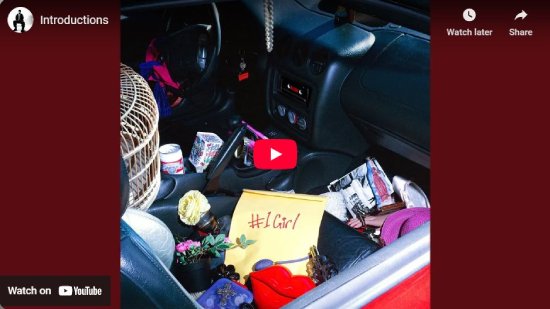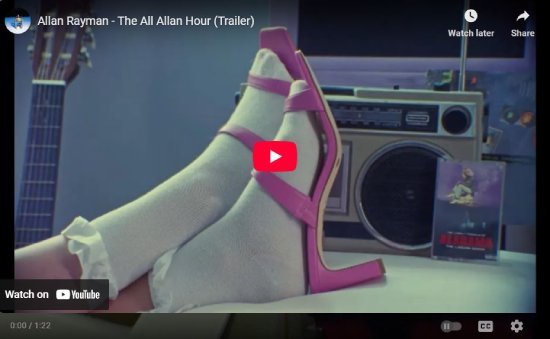Allan Rayman, who debuted almost a decade ago with a cool, gravelly singing voice, has come out with a left-field seventh album, #1 Girl, sung mostly in a gentle upper register. The LP features songs written and sung by Rayman as a fictional female character: a 1990s-era aspiring artist, #1 Girl. It’s set in an imagined world, where Kurt Cobain never existed, and the character of “Allan Rayman” is the equivalent superstar of that era.
The songs range from the high, fragile vocals and singsong melody of “Alright Without You,” to the oh-so-sexy metaphor (or perhaps absolute pet devotion) of “Dog,” to the more familiar roughness of “Head & Heart.” What’s the audience response to #1 Girl’s unusually imaginative perspective, and new vocal style? “Pretty bad,” Rayman answers, nonplussed. “We definitely upset some of the fanbase.”
It’s something of a risk for so successful an artist. Rayman has earned more than 250 million streams across all platforms; found an audience of almost 400,000 monthly listeners on Spotify; sold out tours in Europe, the U.S., and Canada; played festivals like Bonnaroo, Rifflandia, and Lollapalooza; and collaborated with Jessie Reyez, Alex da Kid, and James Vincent McMorrow. But he’s not overly concerned.
“To be honest, I don’t really take into consideration anyone else when I’m creating music or writing stories, so it doesn’t bother me,” he says. “It’s an interesting reaction, and it’s got to be worth something if you’re pulling on some strings for people, so it is what it is. I understand that it’s a drastic change in sound, but I’ve been doing this for 10 years, and if I was just going to do the same thing over and over again, I wouldn’t be having any fun.”
Rayman is in good company. Fans were startled when David Bowie went disco with Young Americans; when Joni Mitchell went jazz with Mingus; when Neil Young went electronic with Trans. These legends followed their muse, wherever it went, for better or worse. If #1 Girl came out as Rayman’s debut album, it’s likely no one would bat an eye. But engaged audiences, even if they allow room for their favourite artists to grow, tend not to want them to change so much that they think, “What the fuck is this?” Rayman has made a WTF album.
“I’m lucky enough to not have too many people breathing down my neck, or trying to persuade me to do this and that, so I’ve got a lot of creative freedom, and that allows me to explore what interests me,” says Rayman.
“If I was just going to do the same thing over and over again, I wouldn’t be having any fun”
He explains the concept on “Introductions,” a two-minute audio play. The characters of #1 Girl and the 1990s rock star “Allan Rayman” first appeared on last year’s scene-setting The All Allan Hour. The album #1 Girl begins with a similar set-up, taking us back to 1994, when the fictional “Allan Rayman” walks down his driveway to collect the mail from his security guards, and is given an envelope containing a demo tape and letter from his biggest fan, #1 Girl. “Let’s listen to it,” he mumbles to himself. We then hear the cassette going into the player, and the click of the play button. The first song, “Like Me,” is acoustic, sparse, lo-fi, sung in her voice, followed by “Her Song,” in which you can even hear fingers sliding on the strings.
“The story is that it’s a girl’s demo, who loves an artist who happens to be named ‘Allan Rayman,’ in the ‘90s,” he says. “Now, if I can deliver that story while using Allan Rayman’s songs, that’s the idea. So, the story says that it’s her demo and, of course, it is in the story, but I wrote the songs from my heart and my feeling… It was a challenge to me to write from her perspective, but… it’s not as deep as it sounds. The story is a simple way to deliver the music. I’m trying to have the listener listen to it as though they’re ‘Allan Rayman’ listening to this girl’s demo.”
Rayman says he didn’t second-guess himself, or encounter any blocks, writing the songs as #1 Girl. “Through the relationships I’ve had in my life, I try to think about, ‘What was her perspective on how this ended?,’ not just my perspective,” he says. “Wrong or right, exploring those things for me was healthy, and intriguing, and exciting. I saw it as a cool little challenge as a writer, to put myself into someone else’s shoes that I know and love… I’m not gonna say I understand how someone else truly thinks and feels, but it’s just my take on it, right? It’s fiction.”
As for the lo-fi sound, it was recorded in Los Angeles in sections, some of it on an iPhone, and then Rayman brought the stems back to to his co-producers Moose and Myes “Losh” Schwartz in Toronto. “It’s a demo, at the end of the day,” says Rayman. “I said to the guys, ‘I want this to sound like she made this in her room by herself… I just wanted it to sound demo-y and raw, and I think it does. People can say, ‘Oh, it sounds lazy…’ I understand where they’re coming from, but to me, that was the point.”
Rayman says he’s essentially “a movie guy” and #1 Girl and The All Allan Hour together comprise a short story accompanied by songs. “That’s what I want to lean into, moving forward,” he says.” I’m really obsessed with the idea of playing with different times. It’s heavily inspired by Slaughterhouse-Five, a [Kurt] Vonnegut book about… this guy being ‘unstuck in time.’ For me, it’s cool to try and imagine what different Allan Raymans would sound like.
“Let’s assume there was no Led Zeppelin, and Allan Rayman was the biggest band in the ‘70s. What would a Zeppelin-inspired Alan Rayman album sound like?,” he says. “The ‘90s are one of my favourite eras of music, and I just wanted to make an album that took place in the ‘90s. And to add to the lore, let’s make it take place the day Kurt Cobain dies [April 5, 1994], but there’s no Kurt Cobain in this universe, there’s only Allan Rayman.
“And then, I have little Easter eggs. Like, this girl gets signed, and her debut album drops on the day that Amy Winehouse dies, July 23… but in ’95 or ’96 [not her actual death year of 2011]. I just play with dates that people know, to get conversations started on that back end… For me, [it was,] ‘Let’s make an album that’s inspired heavily by some of my favourite artists,’ like Jeff Buckley and Elliott Smith. This is my favourite project I’ve ever made, in that sense.”

